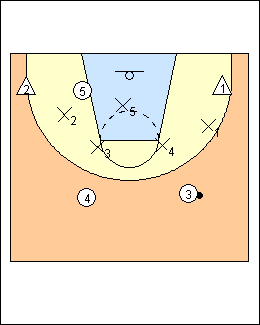Triangle and 2
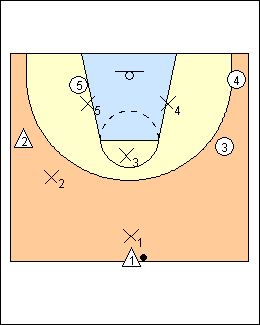 | 1 A combination defence used against teams that have two main scorers, who are guarded man to man by two "chasers" that deny passes to their checks. Remaining defenders play a 3-on-3 triangle zone that helps on the two scorers, which can include a point guard and/or post player. Here X1 and X2 defend scorers 1 and 2 man-to-man, while X3-X4-X5 play a triangle zone. ** Canada Basketball - man-to-man defenders deny all passes to their checks, fight through screens, block out after every shot, and should not follow normal help rules since their job is to keep their checks out of the offence. Some coaches may assign the weakest defenders to these roles since they always have help and aren't required to help. Zone defenders help on scorers, and cover other attackers, who get the ball in scoring range. coachesclipboard.ca - Triangle and Two Defence - X3 is the best athlete, covers elbow to elbow, does not go outside the arc, X4 and X5 cover baseline to wing. Complete denial of the two scorers, make them backcut to the help. When a scorer catches the ball, trap with the point of the triangle. Coach Mac - Triangle and 2 - the chasers play full denial, and not help defence. - the top of the triangle denies the high post and guards the ball above the foul line (extended) - the bottom triangle defenders defend the low post, guard the ball below the foul line, and play weakside help defence. Hoop Tactics - Triangle and Two - the triangle and two can be used as a change of defence to catch an opponent off guard. Three defenders assume a triangle zone, the other two (chasers) play all-out pass denial against their assigned opponents. The triangle provides strong backside support against back cuts (the chasers can really over-play) and dribble penetration (double team an outstanding scorer). Tab Baldwin (FIBA Assist issue 10) - X1 and X2 defend with full denial, or more passive help-oriented defence. X3 plays mid-post to high post on both sides (not beyond the arc), switches all ballscreens in his area, and helps on dribble penetration by 1 or 2. X4 and X5 play mid-post extended to the baseline on the perimeter. coachesclipboard.net - best, quickest, hardest-working defender X3 covers the foul-line area and above, X4 and X5 play on the low blocks and have corner responsibilities too. Julio Lamas (FIBA Assist issue 13) - X1 and X2 play face-to-face, never help on dribble penetration, but do help a helper. Triangle and 2 Junk Defence - a variation is to have the triangle players set up in a line along the split line. Coach & AD - Triangle and 2 - your best defenders should be assigned to guard the opposing team's best two shooters. X3 is responsible for denying penetration and watching the high-post area. bbhighway.com - you might be just as effective playing good man defence and completely denying the two scorers. If you play triangle and 2, defend the two main players, the hot shooter and probably the point guard, taking the player that organizes the offence out of the game. A team with a two-guard system wouldn't be nearly as much affected. |
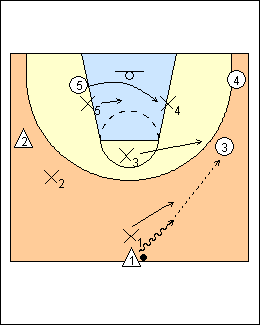 | 2 Coach Mac - X3 takes a pass to 3 above the foul line, X4 fronts the low post, X5 is in the middle of the lane. Coach & AD - where the opposing point guard is defended man-to-man, the top of the triangle closes out on a pass to the wing and X5 covers the high-post area. X3 stays in to help with penetration and the high post until the ball is passed to the wing. Tom Billeter (coachingbetterbball.blogspot.com) - the idea is for X1 to force the ball out of point guard 1's hands then deny a pass back. If you don't have a great 1-on-1 perimeter defender, put the worst help defender on 1, he is always making contact, denying passes, and never playing help defence. Second man defender X2 plays regular man defence and gives help. |
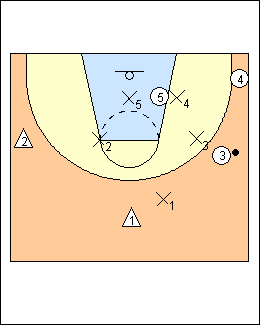 | 3 Coach Mac - X5 is ready to close out on a skip pass. Baldwin - X3 has ball, playing "area" defence, not allowing non-shooter 3 to penetrate or get a good shot, but not consistently pressuring the ball. X4 fronts the low post, X5 zones the midline, defending the weakside post and offering backside help to X4. bbhighway.com - the most common way to play against a triangle and 2 is to have a ballside low post and run the third non-scorer to the ballside corner, this can cause the bottom of the triangle to step out, opening up the post for an easy shot. If the player in the corner gets hot, the triangle and 2 is almost immediately neutralized. Billeter - post defenders always play behind the post. |
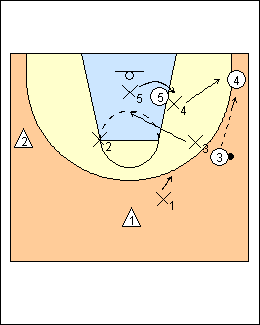 | 4 On a pass to the corner, X4 takes the ball, X5 plays behind the low post, X3 covers the high post. Coach Mac - X4 takes a pass to the corner (including a skip pass from the top), X5 plays behind a low post, X3 covers below the elbow. coachesclipboard.net - X3 covers the ballside low block when the ball goes into the corner. Lamas - X4 runs to cover 4, X5 guards the low post on the ballside, X3 slides toward the baseline in the middle of the lane. Canada Basketball - some coaches prefer to have the player guarding the low post play on the bottom side when the ball is in the corner, this can be effective but allows the low post to seal the defender when the ball is reversed. coachingbball.proboards.com - use 3-2 or 1-2-2 point zone rotations for the triangle, just take the elbow defenders out, they play man-to-man. Similarly, take the top defender out of a 1-3-1 (he plays man), use 1-3-1 rotations for the zone (for a diamond and 1). For a tandem and 3, the middle and baseline players use 1-3-1 rules, the point and wing players match up and play man-to-man. Canada Basketball - in a diamond and 1, the bottom player can cover the corners as in a 1-3-1, or keep him in the key area and cover the corners with the wingers. Coach and AD - you can send X4 out to defend the corner and X5 covers 5, or decide not to go out if 4 is not a three-point shooter or it's out of the opponent's offensive scheme. |
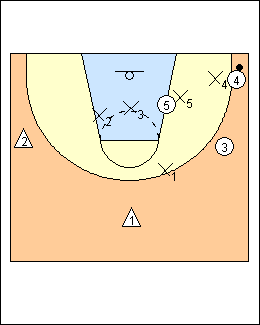 | 5 Baldwin - X4 plays area defence, "soft" on the ball, making the pass to 5 difficult. X5 comes across to play behind low post 5 when X4 is extended. X3 plays weakside below the foul line, and takes a pass out of the corner to the top or wings. X4 would hedge down on a pass to 5 but not double team. Wikipedia - the biggest weakness of the triangle and 2 is its vulnerability to cutters through the lane, and also good passing from the forward spots. Lamas - zone defenders must anticipate a pass to the low post when the ball is below the foul-line extended. coachesclipboard.ca - trap with the top player if the ball goes into the post. Coach Mac - when the ball is in the low post, the top triangle defender should sink down and be ready to help. The top defender guards the ball any time it goes into the high post. Coach Mac - on a corner-wing skip pass, X3 closes out if the ball is above the foul line, X5 closes out below the foul line. |
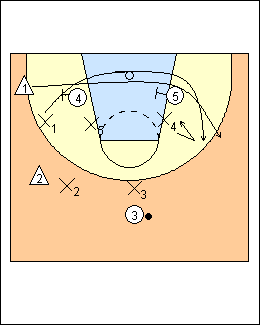 | 6 Hoop Tactics - when an outstanding scorers does get the ball, the triangle zone supports against dribble penetration. Here X4 would double-team a baseline drive, or X3 trap a middle drive. Coach Mac - when an outstanding scorer gets the ball, the triangle zone defenders must collapse back into their triangle positions so they're in position to help on the scorers. This should encourage the scorers to pass to a teammate. coachesclipboard.ca - when a scorer catches the ball, trap with the point of the triangle. |
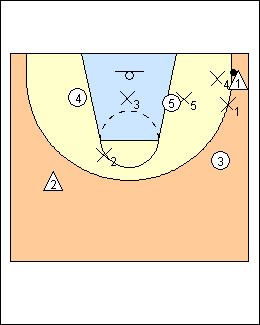 | 7 Hoop Tactics - the Triangle and 2 can be used against strong inside and outside players. The triangle zone and chaser will double team a low post player. Here is the chaser on post 5, X2 is the other chaser, on 2. Coach Mac - the triangle and 2 is primarily effective against perimeter players. If you chase a player who mostly posts up on the block, the lane can become too congested and with two defenders playing in the same spot. betterbasketballcoaching.com - if you use a big man to guard 5 and expect he will be low in the key a lot, consider flipping the triangle to have two players at the top and one at the bottom. bbhighway.com - in some cases you might choose to go man-to-man on a post player, but from a defensive spacing standpoint this isn't very effective use of your players. See Inverted Triangle below. |
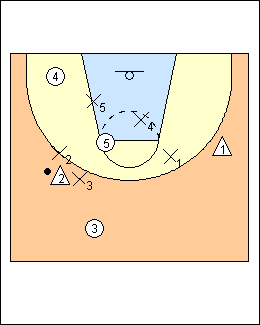 | 8 Screening coachesclipboard.ca - when a scorer is coming off a screen his defender trails, the triangle extends, bumps the curl, and watches for the screener slipping or second cutting to the perimeter. The triangle can help on a curl but not on a fade. Trap a ballscreen, or string it (over/under). Option - X1 and X2 can switch if 1 and 2 screen for each other, but otherwise do not switch on screens. Lamas - if 1 or 2 gets an off-ball screen, the screened defender channels the cutter into the middle to get help. On a wing ballscreen, push the ballhandler toward the baseline except if the screen occurs between both scorers, then switch. Baldwin - on a high or corner ballscreen for a scorer, X3 switches to the scorer coming off the screen, the scorer's defender takes X3's place in the triangle. Billeter - it will be critical for X1 to be good at tag and trail as the offence will try to run 1 through double and triple screens. Switch ballscreens. |
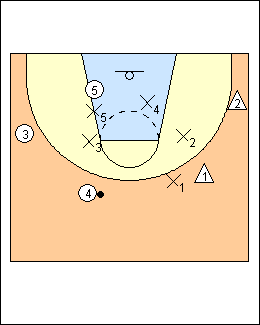 | 9 Rick Majerus - X2 is two passes from the ball, he doesn't hug 2, he gets off him in a pistols position. On a pass to 3, X3 takes ball, X5 butt fronts or face fronts 5, 4 is not a concern. |
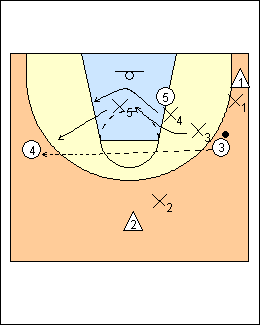 | 10 Inverted Triangle Canada Basketball - the point of the triangle should be on the foul line when the offensive team has a strong low-post game. An inverted triangle is stronger if the opposition shoots well from the outside or there is a defender who should be kept close to the basket, Baldwin - if the offence puts 1 and 2 in the corners and two perimeter players in the guard slots, invert the triangle and bring X4 or X5 to the top, the bottom player is basically playing man-to-man (shown). coachesclipboard.ca - triangle players remember the concept that "they have 3, we have 3". If they bring two up, we bring two up, the biggest player stays on the baseline. Coach & AD - the offence will try to flatten out the defenders that are on a man along the baseline, then split the defender on the top of the triangle. In this case you will invert the triangle, move one of your post defenders to the elbow. |
This page was made with Basketball playbook from Jes-Soft
